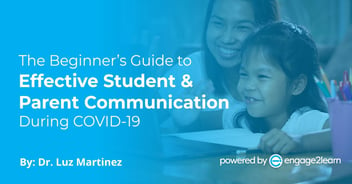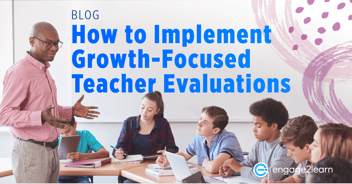A Beginner’s Guide to Blended Learning
What is Blended Learning Anyway?
Technology integration isn’t just a hot topic in education, and “Blended Learning” is far more than a buzzword….here today, gone tomorrow. It is the way of the future to ensure student-centered learning environments, which prepare our students for jobs that don’t yet exist! At the 2019 TASA Midwinter Conference in Austin, Jaime Casap, Chief Education Evangelist for Google, noted that the technology our students use currently will be the least innovative device they’ll ever see. For my Y2K Generation, I likened that notion to playing Oregon Trail on the original, bulky Apple desktop computer or the Zach Morris cell phone that required its own luggage!
The Institute for the Future, a strategic research and educational organization, partnered with Dell Technologies to conduct a study detailing Emerging Technologies’ Impact on Society and Work in 2030. The result? Nearly 85% of jobs that today’s learners will eventually fulfill have not been invented (source). That is a lofty task for all of us as educators. Unfortunately, just purchasing innovative technology isn’t enough. As all teachers will attest, technology pitfalls abound in any given classroom, on any given day: too few devices, devices not working properly, poor WiFi connectivity, not enough bandwidth, and so on and so forth. Yet, Catlin Tucker – blended-learning guru and educational thought-leader – said it best in a recent article published in ASCD’s Educational Leadership: “Even though many of us don’t have technology-rich classrooms, the rapidly evolving education landscape requires us to incorporate technology to customize student learning. Blended learning, with its mix of technology and traditional face-to-face instruction, is a great approach” (source).
Blended learning combines in-person and online instruction, creating a seamless learning experience. It combines traditional classrooms with technology, giving students access to educational content anywhere, anytime.
The Value of Digital Learning and Blended Learning Techniques
According to a recent study conducted by MIT, the value of digital learning extends to students and teachers alike (source). The table below details the potential impact of an autonomous, 21st Century Classroom, and Blended Learning is the quickest, sure-fire way to make that shift from traditional learning. But where do you begin? Blended Learning is actually a broader term for a multitude of techniques for technology integration, ranging across a spectrum from a fully Flipped Classroom to a simpler Station Rotation model. Regardless of which Blended Learning strategy you choose to implement, it is likely that you and your students will benefit.
Value of Digital Learning
| Blended Learning helps learners: | Blended Learning helps teachers: |
| Learn more efficiently | Leverage time better |
| Learn more fully | Spread knowledge widely |
| Learn with mastery | Engage a worldwide audience |
| Learn the best way | Build learning modules quickly |
| Learn anytime, anywhere | Improve instructional techniques |
Dream Big, but Start Small…with Station Rotation
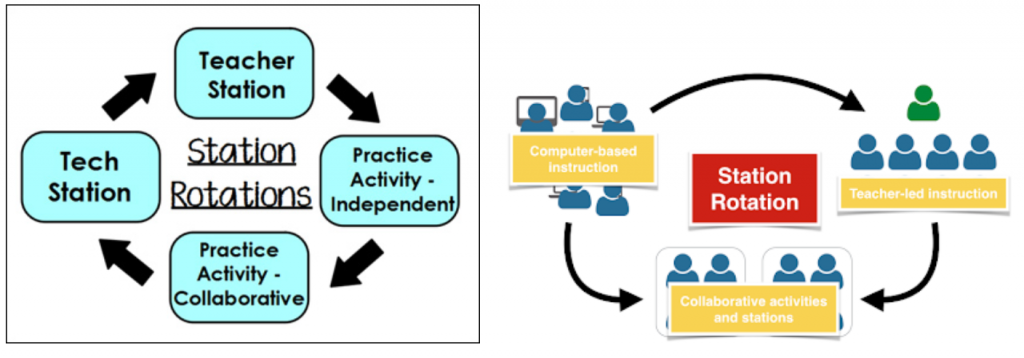
Station Rotation first gained notoriety in the primary grades, specifically with the differentiated, small-group learning environment Balanced Literacy and Guided Math foster. “Center Time” is often synonymous with young learners and the unique classroom management style of the brave souls eager to work with them (myself included). But in our modern era of education, it is imperative that all learners embody the Life-Ready Skills necessary for success in the world outside of their school walls; collaborative, student-led learning is the necessary path to that end.
While it remains true that small-group instruction is no small feat, Station Rotation is possible with any age-group and within any content. As noted in The Basics of Blended Learning, “Giving students control over their learning process requires that they know how to communicate, collaborate, and solve problems in groups, pairs, and individually. This work can be messy, loud, and disorganized, but in the end, the learning is much more meaningful.” Station Rotation is simply the addition of an intentional technology center or station if you will, to which all students “visit” during their small-group learning cycle.
While it remains true that small-group instruction is no small feat, Station Rotation is possible with any age-group and within any content. As noted in The Basics of Blended Learning, “Giving students control over their learning process requires that they know how to communicate, collaborate, and solve problems in groups, pairs, and individually. This work can be messy, loud, and disorganized, but in the end, the learning is much more meaningful.” Station Rotation is simply the addition of an intentional technology center or station if you will, to which all students “visit” during their small-group learning cycle.
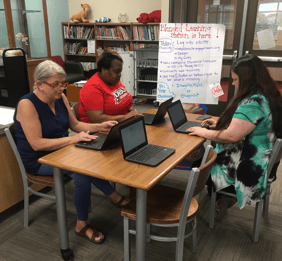
As depicted above, Station Rotation involves three to four distinct learning ventures:
1) Teacher-Led Instruction
2) Do-It-Yourself (DIY) Activities
3) Collaborative Activities
4) Computer-Based Learning
A few weeks ago, I had the honor of working with Kindergarten, 3rd Grade, and 6th Grade teachers in Marshall ISD, who are planning to incorporate Station Rotation into their everyday instruction as part of their Math Innovation Zone (MIZ) grant. Together, we devised a fool-proof plan for Station Rotation and even practiced as their learners will experience it. Follow these tips below for seamless implementation in your classroom:
- Use a timer or visual cue (like a slide deck) to manage the duration of each station.
- Establish a concise clean-up and transition protocol, such as one minute of a catchy song!
- Post instructions at each station. *For young learners, use icons or take pictures of them conducting that station properly and post them!
- Incorporate collaborative Teaming by having small groups take on team roles and establish norms.
- Develop a Conflict Resolution Protocol beforehand: If ________ happens, I can do ____________.
- Encourage your students to develop a Growth Mindset.
- Model, model, model! See evidence below of REAL teachers modeling Station Rotation.
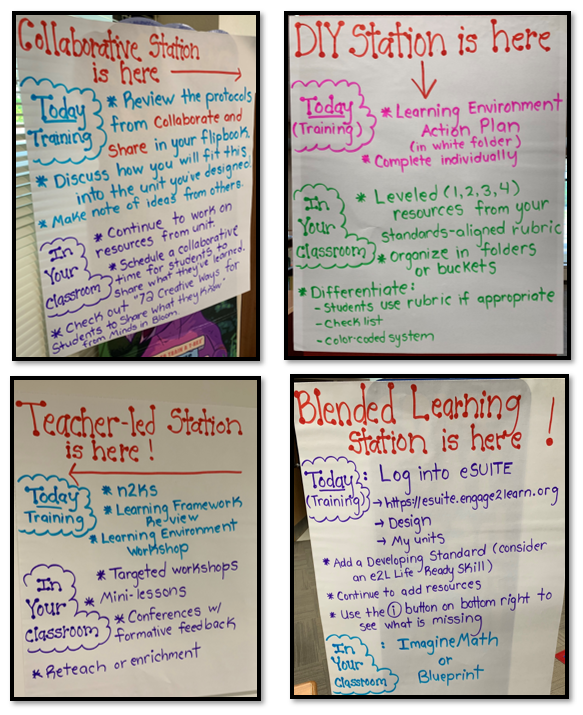
Advantages of Blended Learning:
1) Customized Learning at the Student's Pace
Blended learning allows the student to tailor education to their individual strengths and weaknesses, providing them with additional support or challenging materials as needed.
2) Boost Engagement
By integrating technology for active, immersive learning, blended learning offers interactive, multimedia, gamification, and collaborative online platforms that enhance motivation and participation as a student.
3) Embrace Freedom
With blended learning, students have the power to shape their learning path, encouraging independence and self-directed learning. It opens up a world of opportunities, equipping them with the skills needed to thrive in the digital age.
4) Empower Educators through Data-Driven Instruction
Through technology integration in blended learning, educators gain access to real-time data that provides a comprehensive understanding of growth and unique learning needs.
Instructional Coaching-GroweLab
engage2learn recently launched its all-in-one talent development platform- GroweLab. It supports educators with job-embedded, evidence-based coaching to enhance instructional practice and improve student outcomes.
With a user-centered interface designed around coaching principles, GroweLab maximizes the user experience with the following:
Simplify roster management, track coaching interactions, and document classroom observation with ease for coaches.
- Earn microcredentials to develop skills, build professional portfolios.
- Access 24/7 asynchronous learning with a rich resources library and online courses.
- Support all school/district staff, both instructional and non-instructional.
- Personalize growth through self-paced and real-time coaching interactions to accommodate diverse learning styles and schedules.
- Offer education analytics focused on coaching and talent development, tracking the growth of connected teachers and students.
- Enhance communication between coaches and coachees for increased efficiency and capacity.
GroweLab was designed to keep teachers growing in the skills and competencies proven to reduce teacher burnout and improve student outcomes. Blended Learning is one of the many talent development program examples of effective professional development for teachers that can be implemented to better support students.
Interested in a Demo of GroweLab? Contact us.

